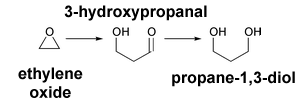Biological Feedback from Sir Philip Cohen
Interview by David Bradley

Sir Philip Cohen might one day be known as 'Professor Phosphorylation'
for his major contribution to the field of protein research. Adding and
removing phosphate groups from proteins is key to countless processes in
the cell including the development of cancer. As Director of the MRC
Protein Phosphorylation Unit at the University of Dundee, Sir Philip feels
that the coming of medical research to the town has breathed new life into
this Scottish town.
Pores for thought
A new metal-organic porous material composed of elaborate organic cage molecules has been synthesised by US chemists as a new alternative to using zeolites in applications where those materials don't work. After synthesis, the pores contain water
 which can readily be removed and allow other small molecules to be trapped inside for separation and catalysis and for the development of selective sensors.
which can readily be removed and allow other small molecules to be trapped inside for separation and catalysis and for the development of selective sensors.
Roger Harrison and colleagues at Brigham Young University, in Provo, Utah, point out how the most valuable feature of zeolites is their porous structure, which allows them to function in a variety of roles such as molecular sieves and as ion exchange materials. Now,
using a cobalt complex with a cup-shaped resorcinarene molecule that has four carboxylates positioned on its upper rim as an organic ligand and calcium as counter ions, the researchers have synthesised a material with metal and organic components. The four perpendicular
carboxylate-binding groups on the resorcinarene cages provide sites to which calcium ions can bind and lead to the assembly of the cages into arrays with
zeolite-like pores and channels.
The resulting compound has a zeolite like porous structure and adsorbs water but is not based on silicates or aluminates. Even though part of their framework is organic, preliminary results indicate these materials retain their structure even if the water or solvent molecules are removed and survive temperatures as high as 300 Celsius.
The material can be made to lose its water molecules simply by heating but the researchers point out that not surprisingly,
after releasing water, it can re-adsorb it.
They found that when the dehydrated material was cooled in the presence of a stream of water vapour the amount of water that was lost is regained. They have demonstrated that this process of dehydration and adsorption can be repeated with the same amount of water being adsorbed each time, which shows that the material does have zeolite-like properties.
The team reports its results in detail in Chem Commun, 2000, 1387. [DOI: 10.1039/b003187I].
Back to main page
Hydroformylation formula
A cheap and easy way to modify epoxides by hydroformylation can, according to a German team, produce beta-hydroxyaldehydes, which are in turn readily hydrogenated to 1,3-diols common starting materials for a wide variety of applications.
Recently, propane-1,3-diol has begun attracting  considerable
industrial interest as an intermediate for the synthesis of polyester fibres and films, says Wilhelm Keim of RWTH Aachen and his colleagues. The team has for the first time used cobalt complexes to catalyse the hydroformylation process in high selectivity and yield and so paving the way for an economic approach to such
diols.
considerable
industrial interest as an intermediate for the synthesis of polyester fibres and films, says Wilhelm Keim of RWTH Aachen and his colleagues. The team has for the first time used cobalt complexes to catalyse the hydroformylation process in high selectivity and yield and so paving the way for an economic approach to such
diols.
Under standard epoxide hydroformylation conditions special catalysts and ligands are needed to suppress side reactions such as isomerisation and hydrogenation. However, the development of phosphorus-containing co-reagents (P-O ligands) for the rhodium-catalysed hydroformylation of olefins provides excellent yields in this conversion; far superior to those with diphosphine compounds such as dppe (1,4-Bis(diphenylphosphino)ethane) and dppm (bis(diphenylphosphino)methane) as co-reagents. Keim's team reasoned that the related hydroformylation of epoxides might proceed well using a P-O ligand and a transition metal catalyst too.
They prepared their catalyst 'in situ' under the applied reaction conditions from octacarbonyl cobalt and dppmO (the P-O analogue of dppm) in toluene as solvent. Ethylene oxide was converted to 3-hydroxypropanal with some 89% selectivity and subsequent hydrogenation of this aldehyde yielded 32% propane-1,3-diol.
According to Keim and his colleagues, the dppmO system was far more effective than the simple diphosphine reagent dppe producing higher selectivities and yields. She points out that using simple monodentate phosphine compounds as a control yield virtually no diol product hinting that the chelate effect is an important part of the catalytic mechanism.
Find out more in Chem Commun, 2000, 1419 [DOI: 10.1039/b002703k]
Back to main page
 which can readily be removed and allow other small molecules to be trapped inside for separation and catalysis and for the development of selective sensors.
which can readily be removed and allow other small molecules to be trapped inside for separation and catalysis and for the development of selective sensors.
 considerable
industrial interest as an intermediate for the synthesis of polyester fibres and films, says Wilhelm Keim of RWTH Aachen and his colleagues. The team has for the first time used cobalt complexes to catalyse the hydroformylation process in high selectivity and yield and so paving the way for an economic approach to such
diols.
considerable
industrial interest as an intermediate for the synthesis of polyester fibres and films, says Wilhelm Keim of RWTH Aachen and his colleagues. The team has for the first time used cobalt complexes to catalyse the hydroformylation process in high selectivity and yield and so paving the way for an economic approach to such
diols.